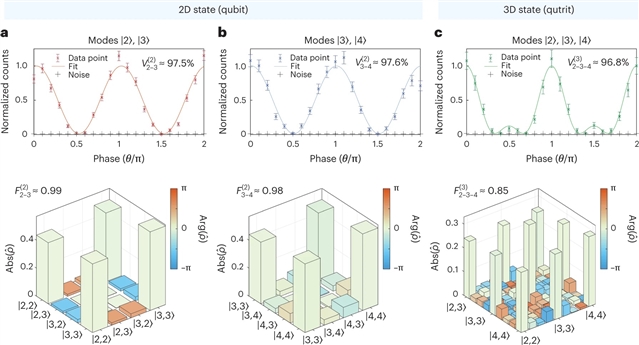
近日,德国汉诺威莱布尼兹大学的Michael Kues课题组与荷兰特温特大学的Klaus-J.Boller等人合作,成功发现了用于产生纠缠qubit/qudit态的全片上光子turnkey量子光源。相关成果已于2023年4月17日在国际学术期刊《自然—光子学》上发表。
该研究展示了一个完全集成的量子光源,它通过整合激光腔、一种高效的可调噪声抑制滤波器(>55dB)利用Vernier效应,以及一个非线性微环实现了通过自发四波混频产生纠缠光子对。这一技术克服了使用外部笨重的激光器的挑战,从而实现了在紧凑、坚固、可扩展的芯片格式中实现和处理光学纠缠量子态的应用,这种应用包括长距离的量子安全通信、量子加速信息处理和非经典计量学。该混合量子源采用电泵InP增益段和Si3N4低损耗微环滤波器系统,表现出高性能参数,包括在电信波段上的四个谐振模式中产生光子对,并以高符合-偶然比(约80)检测到约620Hz的光子对。
该源可直接生成高维频率分组纠缠的量子态(qubits/qudits),并通过干涉测量验证了其可视度高达96%(违反贝尔不等式),通过状态重构也显示了高达99%的保真度。利用混合光子平台的这种方法,可以实现可扩展、商业化、低成本、紧凑、轻量级和可现场部署的纠缠量子源,这对于实际应用如量子处理器和量子卫星通信系统至关重要。
据悉,最近,集成光子学已成为实现和处理紧凑、稳健和可扩展芯片格式中的光学纠缠量子态的领先平台,应用于远距离量子安全通信、量子加速信息处理和非经典计量学。然而,迄今为止开发的量子光源依赖于外部笨重的激光激发,使它们成为不可重复、不实用的原型设备,限制了它们的可扩展性和从实验室转移到实际应用中的能力。
附:英文原文
Title: Fully on-chip photonic turnkey quantum source for entangled qubit/qudit state generation
Author: Mahmudlu, Hatam, Johanning, Robert, van Rees, Albert, Khodadad Kashi, Anahita, Epping, Jörn P., Haldar, Raktim, Boller, Klaus-J., Kues, Michael
Issue&Volume: 2023-04-17
Abstract: Integrated photonics has recently become a leading platform for the realization and processing of optical entangled quantum states in compact, robust and scalable chip formats, with applications in long-distance quantum-secured communication, quantum-accelerated information processing and nonclassical metrology. However, the quantum light sources developed so far have relied on external bulky excitation lasers, making them impractical prototype devices that are not reproducible, hindering their scalability and transfer out of the laboratory into real-world applications. Here we demonstrate a fully integrated quantum light source that overcomes these challenges through the integration of a laser cavity, a highly efficient tunable noise suppression filter (>55dB) exploiting the Vernier effect, and a nonlinear microring for entangled photon-pair generation through spontaneous four-wave mixing. The hybrid quantum source employs an electrically pumped InP gain section and a Si3N4 low-loss microring filter system, and demonstrates high performance parameters, that is, pair emission over four resonant modes in the telecom band (bandwidth of ~1THz) and a remarkable pair detection rate of ~620Hz at a high coincidence-to-accidental ratio of ~80. The source directly creates high-dimensional frequency-bin entangled quantum states (qubits/qudits), as verified by quantum interference measurements with visibilities up to 96% (violating Bell’s inequality) and by density matrix reconstruction through state tomography, showing fidelities of up to 99%. Our approach, leveraging a hybrid photonic platform, enables scalable, commercially viable, low-cost, compact, lightweight and field-deployable entangled quantum sources, quintessential for practical, out-of-laboratory applications such as in quantum processors and quantum satellite communications systems.
DOI: 10.1038/s41566-023-01193-1
Source: https://www.nature.com/articles/s41566-023-01193-1
